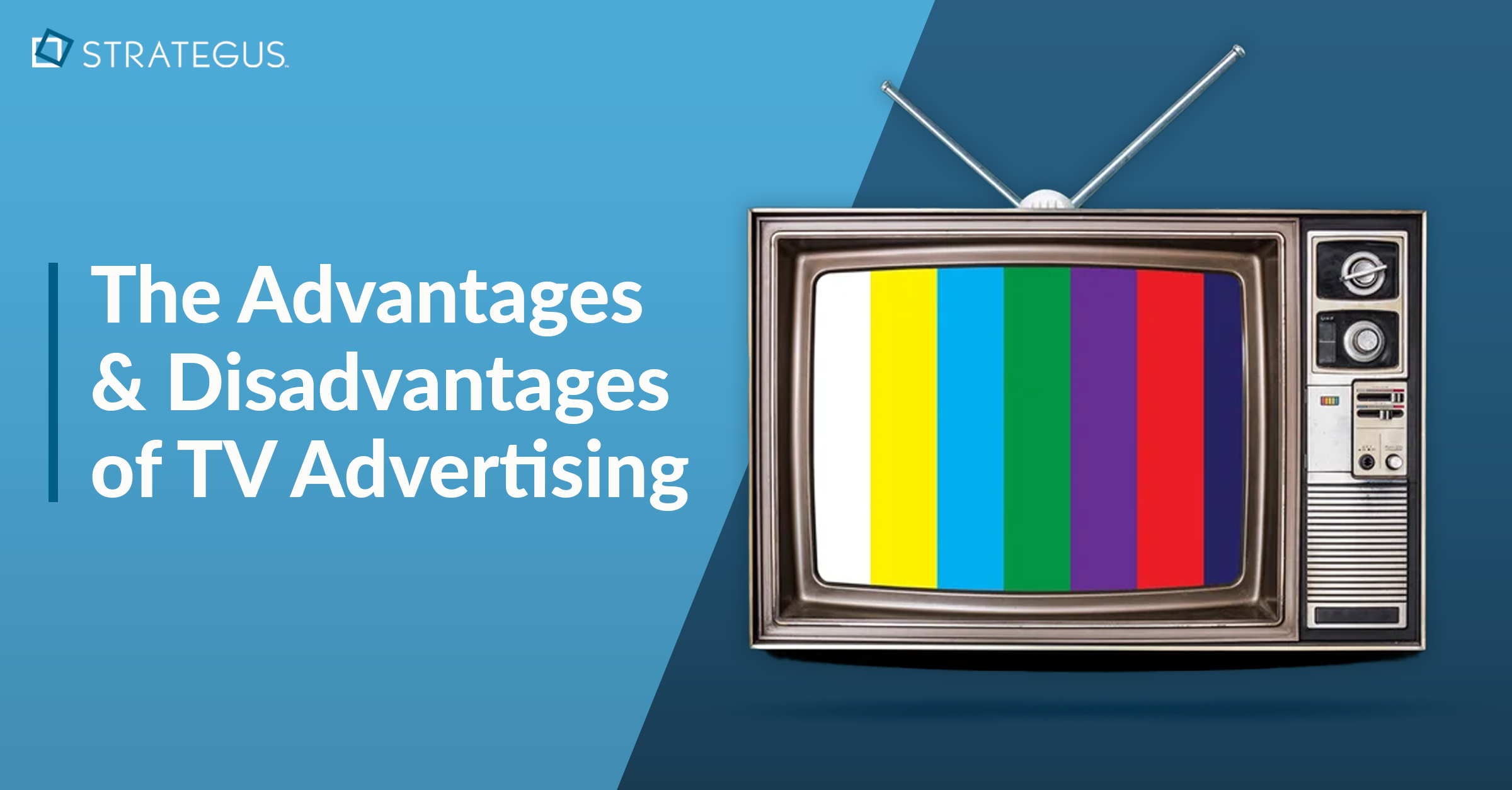- Home
- Strategus Blog
- Television Advertising Advantages and Disadvantages in 2025
Television Advertising Advantages and Disadvantages in 2025
 Traci Ruether
Traci Ruether
10 minutes read

Chances are you remember a few iconic commercials from childhood. For me, the Budweiser ‘Wassup’ campaign comes to mind. It was embedded in early 2000s pop culture, airing during Super Bowl XXXIV and even inspiring a scene in Scary Movie.
The Wassup campaign captured the benefits of TV advertising:
- It was memorable (thanks to the big-screen multimedia impact)
- It evoked emotion (through comedic storytelling)
- It connected viewers (with a shared joke that we were all in on)
- It established brand credibility (by running alongside premium content)
Despite the ways that TV consumption has changed through the years, the advantages of advertising on it remain the same. And in many ways, there’s even more upside for brands today due to the fact that many households have cut the cable cord in favor of streaming TV.
Source: Nielsen
Due to this shift, TV advertising now comes in a couple different flavors: traditional TV and connected TV (CTV) advertising. So what are the pros and cons of traditional TV advertising and how does this compare to CTV advertising?
The TL;DR is that CTV capitalizes on the best aspects of traditional TV advertising while also overcoming many of its limitations. Keep reading for the full rundown.
What are the Advantages and Disadvantages of Television Advertising?
TV ads help you reach a lot of people and make a strong impression, which is great for building brand awareness, but they’re expensive and not very targeted.
Here are the main pros and cons of TV advertising:
Pros:
- Reaches large, diverse audiences
- Strong visual and emotional appeal
- Builds brand credibility
- Ideal for mass-market products
- Boosts brand recall
Cons:
- High production and airtime costs
- Limited targeting compared to digital
- Difficult to measure direct ROI
- Short ad lifespan
- Viewers may skip or ignore ads
Now, let's take a deeper look at the advantages and disadvantages of TV advertising.
What are the Advantages of Television Advertising?
When it comes to ads, few match the impact of those on living room TV. Commercial breaks have long been part of the TV experience, and the best ads entertain just like the shows they accompany.
That storytelling power is what makes TV ads memorable and effective. Take Budweiser’s iconic Wassup campaign:
- Sales rose 2.4%, ending a decade-long decline
- It earned $20 million in free media coverage
Few campaigns reach this scale, but it proves TV’s unique ability to drive results in ways other channels can’t.
Here are the 5 reasons why television ads work:
- Premium and credible: TV advertising places your brand on the largest screen in the household, capturing viewers’ full attention. These ads run alongside premium content that’s professionally produced, which is a stark contrast from the ads placed on social media sites or across the web.
As a result, TV advertising helps enhance brand perception and establish credibility.
- Multimedia storytelling: With sight, sound, and motion, TV ads bring brands to life — thereby making a memorable impact. There’s simply no better way to tell a brand story and build emotional connection with top-of-funnel prospects.
- Broad reach and exposure: The impact of TV advertising on pop culture is undeniable. And a major reason for this is because it connects advertisers with massive audiences, making it a great channel for awareness campaigns.
- High impact and recall: TV ads drive better recall than other channels, which translates to higher purchase intent. In addition to the multimedia storytelling advantage, these ads stay top of mind because they’re watched by tuned-in audiences, on the big screen, in the comfort of their own homes.
Viewers also tolerate ads better than pesky display ads and the like (in part because they’re watching shows they love).
- Co-viewing: Ads delivered to big-screen TV sets are often consumed by multiple viewers simultaneously. This allows for a shared experience and results in more ad impressions.
What are the Disadvantages of Television Advertising?
No marketing channel is without downsides. And while TV advertising still holds a powerful allure, it's important to be aware of its limitations, especially in a world increasingly dominated by digital media.
Here are 7 disadvantages of TV advertising:
- Lacks precise targeting: TV advertising operates on a “spray and pray” model, forcing businesses to broadcast generic messages to large groups in hopes of reaching a handful of prospects.
This is because these ads are purchased using a content-centric approach, requiring advertisers to guess which channels their buyers are tuning into.
- Expensive: Because linear TV lacks precise targeting, it’s often only feasible for big businesses with even bigger budgets. This is why you’re much more likely to see national brands during the commercial break than local businesses and startup companies.
- Passive medium: TV is consumed by passive viewers, making it less actionable than ads that run in clickable environments. More conversion-focused campaigns that aim to drive clicks and other outcomes are better suited for online video or display advertising.
- Difficult to measure: TV ads are measured through likely correlations such as spikes in web traffic after an ad airs. The problem with this is twofold: For one, traditional TV attribution doesn’t account for the lengthy sales cycle between initial ad exposure and conversion.
It also fails to isolate the impact of each touchpoint along the way, leaving marketers in the dark about opportunities for campaign optimization.
- Declining viewership: Streaming TV has surpassed linear in terms of viewership. The ongoing decay of traditional media makes investing in linear TV advertising alone quite risky.
- Potential for ad skipping: Another disadvantage of television advertising is that the ads can be skipped or ignored by simply changing the channel.
While this is also true of streaming services with linear channels, it isn’t the case when streaming video on demand (VOD) content like The Secret Lives of Mormon Wives on Hulu (I would know: I’m guilty of giving that show a try).
- Inefficient and difficult to change: Because TV ad spots are purchased via a lengthy hands-on process between publishers and media buyers, they lack the flexibility of today’s digital marketing channels.
Ad creative, budget, and targeting is often locked in after the sale is finalized — making it challenging to respond to real-time feedback or changing market conditions.
How CTV Changes the Way TV Ads Work
Almost all of the disadvantages above can be chalked up to legacy technology. Traditional TV advertising has been around since 1941, and like all other forms of mass media, it no longer competes with digital alternatives.
Enter Connected TV (CTV) advertising.
Connected TV refers to the smart TVs, gaming consoles, and set-top boxes that viewers use to stream content on apps like Hulu. By extension, CTV advertising describes the ads served within these data-rich ecosystems.
This digital component changes the way that ads are purchased, delivered, and measured — combining the impact of traditional TV with the precision and personalization of digital marketing.
75% of the ads on connected TV (CTV) are placed programmatically, meaning they’re bought and sold on a per-viewer basis like the targeted ads we see on websites and social media.
Advantages of CTV Advertising
Here are 6 reasons why CTV advertising works:
- Targeted and localized: Programmatic CTV lets you target specific audience segments instead of broadcasting to everyone. This precision makes it accessible even for smaller, regional brands.
- Personalized and relevant: CTV ads are served per viewer, allowing brands to customize creative by audience segment. For example, a car dealer can promote SUVs to families actively shopping for one.
- Real-time measurement and attribution: CTV runs in digital environments where you can track performance and tie spend to results. With the right attribution tools, you can connect ad views to site visits, store traffic, or in-store sales.
- Cost-effective and high-performing: You only pay to reach your target audience, cutting out waste and improving ROI. This makes CTV a high-impact option, even for smaller brands.
- Cross-device retargeting: After someone sees your CTV ad, you can retarget them across devices—on YouTube, Spotify, or social media to drive follow-up actions.
- Easy to test and optimize: CTV campaigns aren’t static. With real-time data, you can test, iterate, and optimize quickly, avoiding wasted spend and improving results over time.
Disadvantages of CTV Advertising
While CTV offers many advantages, it’s still a growing channel with a few challenges to consider:
- Specialized and complex: Programmatic CTV is not plug-and-play. It requires experience, technical know-how, and a deep understanding of the streaming ecosystem. That’s why many brands rely on partners like Strategus to manage setup and optimization.
- Fragmented ecosystem: The space is split across streaming services and a layered programmatic supply chain, making it harder to track performance and manage buys—especially for smaller advertisers.
- Risk of ad fraud: CTV is vulnerable to fake impressions and click fraud. Without the right safeguards and partners, ad dollars can be wasted on invalid traffic.
Turn TV Reach Into Measurable Results With Strategus
Traditional TV delivers reach. Digital brings precision. CTV does both — but it’s complex to navigate without the right partner. That’s where Strategus comes in.
Whether you're new to CTV or looking to scale your results, Strategus acts as an extension of your team, bringing strategy, tech, and execution under one roof.
Partnering with Strategus means:
- Advanced audience targeting using first-party, retail, and behavioral data
- Real-time performance tracking through our custom reporting dashboard
- Seamless attribution across online and offline channels with tools like SalesLink
- Omnichannel retargeting to keep your brand top-of-mind across devices
- Managed service execution from campaign setup to optimization, backed by a team of CTV specialists
Ready to launch smarter CTV campaigns?
Frequently Asked Questions
Does TV Advertising Still Work?
Yes, TV advertising still works, especially for mass-market products. It combines visual and auditory elements to create lasting impressions. Despite digital growth, TV delivers unmatched reach and emotional impact. Studies show it drives brand lift, especially when integrated with online channels. It's particularly effective for older demographics and primetime slots.
How Do I Advertise on TV?
To advertise on TV, set your campaign goal, choose your target audience, select relevant channels or programs, and work with a media buying agency. You'll also need a professionally produced ad. Local stations or programmatic platforms like CTV can help smaller brands access TV inventory.
How Does a TV Advert Improve Sales?
TV ads improve sales by increasing brand awareness and recall. Strong storytelling and emotional appeal can create urgency, drive search and web traffic, and influence purchasing decisions, especially when the ad is timed with promotions or product launches.
How Do You Measure the Response to a TV Advertising Campaign?
Use direct response tools like vanity URLs, promo codes, and call tracking to connect ad exposure with outcomes. Track web traffic, leads, and sales during the campaign period. Combine with Nielsen ratings or TV attribution tools for broader impact analysis.
How Do TV Advertisers Know Who Is Watching Certain TV Programs?
Advertisers rely on audience measurement tools like Nielsen ratings, smart TV data, and set-top box analytics. These provide insights into viewer demographics, regional behavior, and time-of-day trends, helping advertisers choose the most effective placements.
How Does CTV Advertising Improve Targeting Compared to Traditional TV?
CTV uses first-party and third-party data to serve ads to specific audiences by demographics, interests, and behavior. This allows advertisers to avoid waste, personalize creatives, and reach viewers across devices — all in a measurable environment.
What's the Difference Between Linear TV and Connected TV (CTV) Advertising?
Linear TV refers to traditional broadcast or cable channels with fixed schedules. CTV refers to ads delivered via streaming platforms on smart TVs or devices. CTV allows programmatic buying, real-time measurement, and precise targeting, unlike linear TV.
Is TV Advertising Effective for Small Businesses?
Traditional TV can be expensive for small businesses, but CTV makes it more accessible with lower minimum spends, targeted placements, and trackable results. Local TV ad bundles and programmatic platforms also help SMBs reach relevant audiences.
How Do I Create TV Ads That Deliver Results?
Use a clear message, emotional storytelling, strong visuals, and a memorable CTA. Hook viewers in the first 5 seconds, show your brand early and often, and align the creative with the audience's interests. Test the concept before launching.
How Do I Measure the ROI of CTV Advertising?
Track metrics like impressions, completion rates, clicks, conversions, and post-view actions (e.g., store visits). Use attribution tools to connect ad exposure to sales or site visits across devices. CTV platforms often offer granular campaign analytics.
What Are the Costs Involved in TV Advertising in 2025?
TV ad costs vary by format. Traditional prime-time national spots can run $100K+ per 30 seconds, while local TV costs as low as $500. CTV ads are bought per impression and are more cost-effective, with lower entry barriers for small brands.

Traci Ruether is a content marketing consultant specializing in video tech. With over a decade of experience leading content strategy, she takes a metrics-driven approach to storytelling that drives traffic to her clients' websites. Follow her on LinkedIn at linkedin.com/in/traci-ruether or learn more at traciruether.com.
Strategus is a managed services connected TV(CTV) advertising agency with over 60,000+ campaigns delivered. Find out how our experts can extend your team and drive the result that matter most.
Talk to an Expert
Table of Contents
Seeking a Custom CTV Strategy That Delivers?
What to read next
App Event Tracking: Tie Mobile App Activity to CTV Campaigns
Let’s say you’re running a CTV campaign for a personal finance app.
5 minutes read

Stop Guessing Who Your Audience Is — Let Their Apps Tell You
Connected TV (CTV) targeting often falls in one of two camps.
8 minutes read
See Who Bought After Your Ad + How Much They Spent
You can’t improve what you can’t measure. And for years, that’s been a major problem with TV advertising.
4 minutes read

First-Party Attribution: Match Ads to Sales With CRM Data
The value of first-party data continues to grow.
7 minutes read













